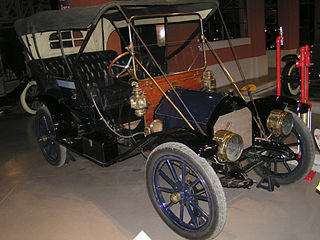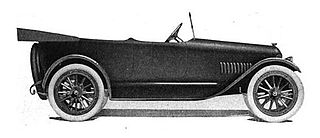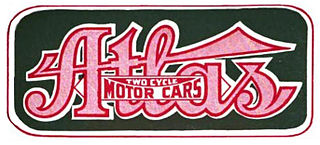
The E-M-F Company was an early American automobile manufacturer that produced automobiles from 1909 to 1912. The name E-M-F was gleaned from the initials of the three company founders: Barney Everitt, William Metzger, and Walter Flanders.

The Ford Model K is an upscale automobile that was produced by Ford. It was introduced in 1906 and replaced the earlier Model B. It was built at the Ford Piquette Avenue Plant. The model K was aimed at the top end of the market and featured an inline-6 giving 40 hp (30 kW). The wheelbase was 120 in (2896 mm) and could be ordered either as a touring or roadster model.

The Ford Model N is an automobile produced by Ford Motor Company; it was introduced in 1906 as a successor to the Models A and C as the company's inexpensive, entry-level line. It was built at the Ford Piquette Avenue Plant.
F. B. Stearns and Company, later known as F.B. Stearns Company was an American manufacturer of luxury cars in Cleveland, Ohio marketed under the brand names Stearns from 1900-1911 then Stearns-Knight from 1911 until 1929.

The Studebaker Light Four was an automobile produced by the Studebaker Corporation of South Bend, Indiana in 1918 and 1919. The car was officially designated Model SH Series 19 and available as a touring car, sedan and roadster.

The Everitt was an American automobile manufactured from 1909 until 1912 by the Metzger Motor Car Company in Detroit.

Penn was the name of three American automobiles of the pioneer era:
The American Automobile and Power Company was an American Brass Era car manufacturer, incorporated in Sanford, Maine, in 1903. They produced the American Populaire during 1904 and 1905.
Kauffman Motor Vehicle Company was a pioneer brass era, American automobile company, built in Miamisburg, Ohio, from 1909 until 1912.

The Cunningham automobile was a pioneering American production automobile, one of the earliest vehicles in the advent of the automotive age. It was produced from 1896 to 1931 in Rochester, New York by James Cunningham, Son and Company.

The Kline Kar was an American automobile built first in York, Pennsylvania, (1910–1912), and then in Richmond, Virginia, (1912–1923). The car was often just referred to as a Kline.
The Sandusky Automobile Company was an automobile manufacturer in Sandusky, Ohio, United States, from 1902 to 1904. It was located at 1114 Camp Street.

The Commonwealth Motors Corporation was a luxury auto company that produced cars from 1917 to 1922. The company was founded in Chicago as Partin-Palmer company in 1913, but in 1915 got into financial trouble. So, in 1917, the name was changed to Commonwealth, and production was moved to Joliet, Illinois.
Geronimo was a pioneer vintage era American automobile, built at 409 South Grand in Enid, Oklahoma, between 1917 and 1920. It was what would today be called an "assembled car", relying on proprietary parts from outside suppliers. In addition, the company made tractors.

The Atlas car was built in Springfield, Massachusetts from 1907-1911.

The Buick 4 was a series of passenger cars produced by the Buick Division of GM from 1909 through 1918, and was available as a touring car, phaeton or roadster. It was available with the Buick Model B as a larger alternative offering a larger engine and better durability. It became the junior sedan in 1914 when the Buick Six was introduced.

The Model S was the first four-seat passenger car produced by Oldsmobile in 1906, offered as a larger alternative to the Model R Curved Dash runabout that appeared in 1901. The advertised price was $2,250. It was Oldsmobile's first four cylinder car and took the top level marketing position above the Model L and the entry-level Model R. It was one of the last independently developed products before they joined General Motors in 1908, and competed against Buick, Ford and other automakers at the time. It was built at the Oldsmobile factory in Detroit and developed by Frederick and Angus Smith, whose father Samuel L. Smith was the primary investor, and R. E. Olds had left the company due to an argument with Oldsmobile Board of Directors.
The Model 42 was an entry-level four seat passenger car produced by GM's Oldsmobile Division in 1914, offered as a replacement to the Oldsmobile Curved Dash runabout when it was discontinued in 1908, and was the junior platform to the Oldsmobile Six introduced in 1913. GM had acquired Elmore Manufacturing Company, Oldsmobile and Oakland Motor Car Company in 1908 and Cartercar and Rainier Motor Car Company in 1909 as their entry-level models, and Oldsmobile products were being repositioned in their new hierarchy as GM began to consolidate operations after William Durant had left.
The Model M was a four-seat passenger car produced by Oldsmobile in 1908, offered as a mid-range alternative to the Model R Curved Dash runabout that appeared in 1901, replacing the Model A. It was the junior sedan to the first six-cylinder sedan called the Oldsmobile Model Z also introduced in 1908, but was larger than the Oldsmobile Model X.
The Oldsmobile Series 28, also known as the Autocrat, was a mid-level four seat passenger car produced by GM's Oldsmobile Division for 1911 and 1912. It was based on the top-level Oldsmobile Limited while using a four-cylinder engine, and was manufactured in Lansing, Michigan.














